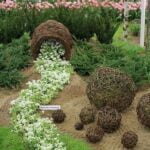Looking for fencing ideas for small gardens? Fencing plays a crucial role in the design and functionality of small garden spaces, offering privacy, security, and aesthetic appeal. It defines boundaries and creates an intimate outdoor space, making it an essential feature for small gardens.
In this article, we will explore the benefits of fencing in small gardens, types of materials to consider, space-saving ideas, DIY projects, maintenance tips, and inspiration for choosing the right fencing for your small garden. Whether you’re looking to enhance security or simply add visual interest to your outdoor area, finding the right fencing solution is key to maximizing your small garden space. So let’s dive into the world of fencing ideas for small gardens.
Benefits of Fencing in Small Gardens
Fencing in small gardens offers a multitude of benefits that go beyond simply defining boundaries. One of the primary advantages is the added privacy and security it provides. With the right fencing, homeowners can create a secluded oasis within their small outdoor space, shielding it from prying eyes and creating a peaceful retreat. Additionally, fencing adds a layer of security by deterring unwanted intruders or animals from entering the garden.
Apart from privacy and security, fencing also contributes to the aesthetic appeal of small gardens. It can serve as a backdrop for beautiful plants and flowers, adding visual interest and depth to the overall design. Furthermore, well-chosen fencing materials and styles can complement the existing architecture of the home, tying everything together into a cohesive and attractive outdoor space.
In relation to optimizing small garden spaces, fencing can effectively define boundaries and create a more intimate atmosphere. By clearly demarcating areas within the garden, such as seating or dining areas, fencing helps to maximize usable space while maintaining an organized layout. When designed thoughtfully, fences can even visually expand the perceived size of the garden by creating depth and perspective.
| Advantages | Description |
|---|---|
| Privacy and Security | Fencing provides privacy from neighbors & enhances security |
| Aesthetic Appeal | Fencing serves as a backdrop for plants & complements home’s architecture |
| Optimizing Garden Space | Fencing defines boundaries & creates an intimate atmosphere in small gardens |
Types of Fencing Materials
When it comes to fencing ideas for small gardens, selecting the right fencing material is crucial. The material not only impacts the aesthetic appeal of the garden but also its functionality and longevity. There are various options to choose from, each with its own set of pros and cons.
One popular option for small gardens is wood fencing. Wood gives a natural and rustic look to the garden, adding warmth and charm to the space. It can be easily customized to fit the specific size and layout of the garden. However, wooden fencing may require more maintenance in terms of staining or painting to protect it from the elements.
Another material to consider is vinyl, which offers a low-maintenance and durable fencing option for small gardens. Vinyl comes in a variety of colors and styles, allowing homeowners to find the perfect match for their garden design. It is also resistant to rotting, fading, and damage from pests, making it a long-lasting choice.
Metal fencing, such as wrought iron or aluminum, is another popular choice for small gardens. Metal fences provide both security and style, adding an elegant touch to the garden. They are also highly durable and can withstand harsh weather conditions. However, metal fences may require professional installation and can be more expensive compared to other materials.
Lastly, decorative options such as bamboo or composite materials offer unique fencing ideas for small gardens. These materials can add visual interest and texture to the garden while still providing privacy and boundary definition. However, it’s important to consider the maintenance requirements and longevity of these decorative options when choosing the right material for a small garden fence.
Choosing the Right Height and Style
When it comes to fencing ideas for small gardens, selecting the right height and style is crucial in maximizing both functionality and aesthetics. The height of your fence should provide the appropriate level of privacy without overwhelming the limited space, while the style should complement the overall design of your garden.
One popular option for small gardens is a low-height picket fence, which adds a touch of charm without obstructing views or sunlight. This type of fence can also create a visual boundary without closing off the space entirely. Additionally, a horizontal slat fence can give the illusion of more space by drawing the eye outward, making it an ideal choice for small gardens.
In terms of style, incorporating elements that match your garden’s theme or existing structures can enhance cohesion and visual appeal. For example, if your garden has a rustic feel, consider using wooden fencing with natural finishes. On the other hand, sleek metal fencing can complement modern or minimalist garden designs.
Ultimately, when choosing the right height and style for your small garden fencing project, it’s important to strike a balance between functionality and aesthetics to create a harmonious outdoor space that feels open yet intimate.
| Height and Style Option | Suitable Garden Themes |
|---|---|
| Low-height picket fence | Charming and cottage-style gardens |
| Horizontal slat fence | Modern or minimalist gardens |
| Wooden fencing with natural finishes | Rustic or traditional gardens |
| Sleek metal fencing | Modern or urban gardens |
Space-Saving Fencing Ideas
When it comes to small gardens, maximizing space is essential. This also applies to the fencing used in these spaces. When considering fencing ideas for small gardens, it’s important to think about options that will not only add privacy and security but also visually enhance the limited outdoor space without taking up valuable room. There are several space-saving fencing ideas that can achieve this balance and add visual interest to a small garden.
One popular option for space-saving fencing in small gardens is the use of vertical gardens. This innovative approach not only adds a touch of greenery but also serves as a natural fence, creating a boundary while incorporating plants into the overall design. Trellises and lattice work are also excellent choices for small gardens, as they provide structure for climbing plants such as ivy or roses, adding a sense of lushness without encroaching on precious square footage.
By utilizing these space-saving fencing ideas, small garden owners can create an outdoor oasis that feels open and airy while still offering privacy and security. These options not only enhance the aesthetic appeal of the garden but also contribute to a sense of tranquility and intimacy within the outdoor space.
Experimenting with different vertical elements and plantings can transform a small garden into a welcoming retreat that feels much larger than its actual size, making the most out of every inch available. As such, when looking for fencing ideas for small gardens, consider these innovative approaches that make the most out of limited space while adding beauty and functionality to your outdoor area.
DIY Fencing Projects for Small Gardens
Simple Wood Pallet Fence
One cost-effective and eco-friendly fencing idea for small gardens is to repurpose wood pallets into a charming fence. This DIY project involves sanding, painting, and assembling the pallets to create a unique and rustic fence. The height of the fence can be adjusted according to the garden’s needs, making it a versatile option for small spaces. Not only does it provide privacy and security, but it also adds an attractive design element to the garden.
Vertical Garden Fence
Another space-saving fencing idea for small gardens is to combine fencing with vertical gardening. By attaching trellises or planters to a fence, you can create a green wall that serves as both a boundary and a living garden.
This not only maximizes the use of vertical space but also adds visual interest and natural beauty to the garden. Depending on the plants chosen, this DIY project can also attract beneficial insects and wildlife, contributing to the overall biodiversity of the garden.
Miniature Gabion Wall
For a modern and minimalist look in small gardens, consider building a miniature gabion wall as a DIY fencing project. With wire mesh boxes filled with stones or pebbles, this type of fence adds texture and depth while requiring minimal maintenance.
The gabion wall can act as a visual boundary without closing off the space completely, creating an open yet defined outdoor area. Additionally, this project allows for creativity in choosing different colors and sizes of stones to customize the look of the fence.
By exploring these DIY fencing projects for small gardens, homeowners can find practical and creative solutions that suit their specific needs and preferences. Whether seeking privacy, security, or aesthetic enhancement in their small garden spaces, these DIY ideas offer budget-friendly options that are easy to install and maintain over time.
Maintenance and Care Tips
Maintaining and caring for fencing in small gardens is essential to ensure the longevity, functionality, and visual appeal of these outdoor spaces. Proper maintenance can also help protect the fencing from weather damage and preserve its aesthetic qualities. Here are some tips for maintaining and caring for fencing in small gardens:
Regular Cleaning
One important aspect of maintaining fencing in small gardens is regular cleaning. Depending on the material of the fence, it may require different cleaning methods such as pressure washing, scrubbing with a mild detergent, or simply hosing it down. Regular cleaning helps prevent the buildup of dirt, grime, and debris that can detract from the overall appearance of the fence.
Inspecting for Damage
It’s crucial to regularly inspect the fencing for any signs of damage such as cracks, loose panels, or rust (if using metal fencing). Addressing these issues promptly can prevent further damage and prolong the lifespan of the fence. For wooden fences, checking for signs of rot or insect infestation is also important in order to address these issues before they escalate.
Weather Protection
Small garden fences are exposed to various weather conditions which can cause wear and tear over time. Applying a protective sealant or paint can help shield wooden fencing from moisture and sunlight, while metal fences may benefit from a protective coating to prevent rust. Additionally, installing windbreaks or barriers can protect the fence from strong winds during storms or inclement weather.
By following these maintenance and care tips for fencing in small gardens, garden owners can ensure that their fences remain not only functional but also visually appealing for years to come. Taking proactive steps to maintain the quality and condition of the fencing will ultimately enhance the overall beauty and functionality of small garden spaces.
Inspiration for Small Garden Fencing
Fencing plays a crucial role in small gardens, as it not only provides privacy and security but also contributes to the overall aesthetic appeal of the outdoor space. When it comes to choosing the right fencing for a small garden, there are many factors to consider, from the materials used to the height and style of the fence.
In addition to these considerations, finding inspiration for creative and effective fencing ideas is essential in maximizing the potential of a small garden.
One of the key considerations when seeking inspiration for small garden fencing is choosing a material that complements the overall design of the space. For example, wood fencing can add a natural and rustic charm to a small garden, while metal fencing lends a contemporary and sleek look. By exploring different options and considering how each material will integrate with the existing elements of the garden, individuals can find the perfect inspiration for their fencing project.
In addition to material, considering unique and space-saving fencing ideas can provide valuable inspiration for small gardens. This may include incorporating vertical gardens into fence designs or utilizing trellises and lattice work to add visual interest without taking up valuable space.
These creative ideas not only contribute to the aesthetics of the garden but also serve practical purposes in enhancing the functionality of a small outdoor area. Ultimately, by drawing inspiration from various sources and considering innovative solutions, individuals can find the perfect fencing ideas for their small gardens that enhance both form and function.
Conclusion
In conclusion, fencing plays a crucial role in enhancing the functionality and design of small gardens. The right fencing not only provides privacy and security but also adds aesthetic appeal to outdoor spaces. When selecting fencing for small gardens, it is important to consider the space-saving aspect, maintenance requirements, and the overall style of the garden. By exploring different fencing materials, heights, styles, and creative ideas, homeowners can maximize the potential of their small garden spaces.
Choosing the right fencing for small gardens is essential in creating a more intimate and visually appealing outdoor area. Whether it’s using trellises and vertical gardens to add greenery or opting for decorative metal fencing for a modern touch, there are countless options to explore.
It’s also important to consider maintenance and care tips to ensure that the fencing remains in good condition over time. With proper upkeep, small garden fences can continue to enhance the beauty of the outdoor space for years to come.
Overall, when it comes to fencing ideas for small gardens, there is no one-size-fits-all solution. It’s about finding a balance between practicality and aesthetics while maximizing the limited space available.
The key is to experiment with different ideas and materials to find the perfect fencing solution that complements the unique design and layout of your small garden. By exploring various options and being open to DIY projects, homeowners can create a charming and functional outdoor oasis with the right fencing choices.
Frequently Asked Questions
What Is the Cheapest Fencing for Garden?
The cheapest fencing for a garden is typically wire or chicken wire. These options are affordable and can effectively keep out pests and small animals from the garden.
What Is the Cheapest Option for Fencing?
The cheapest option for fencing would be to use materials such as wooden pallets, bamboo, or vinyl. These materials are usually cost-effective and can be easily installed for a budget-friendly fencing solution.
How Do You Fence a Small Garden?
Fencing a small garden can be done using smaller panels or sections of fencing material. It’s important to measure the area accurately and choose a style of fencing that complements the garden’s aesthetic while still providing security and protection.

Welcome to my gardening blog! I am passionate about plants and enjoy sharing my knowledge and experiences with others. In this blog, I will write about everything related to gardening, from tips on how to get started to updates on my own garden projects.





